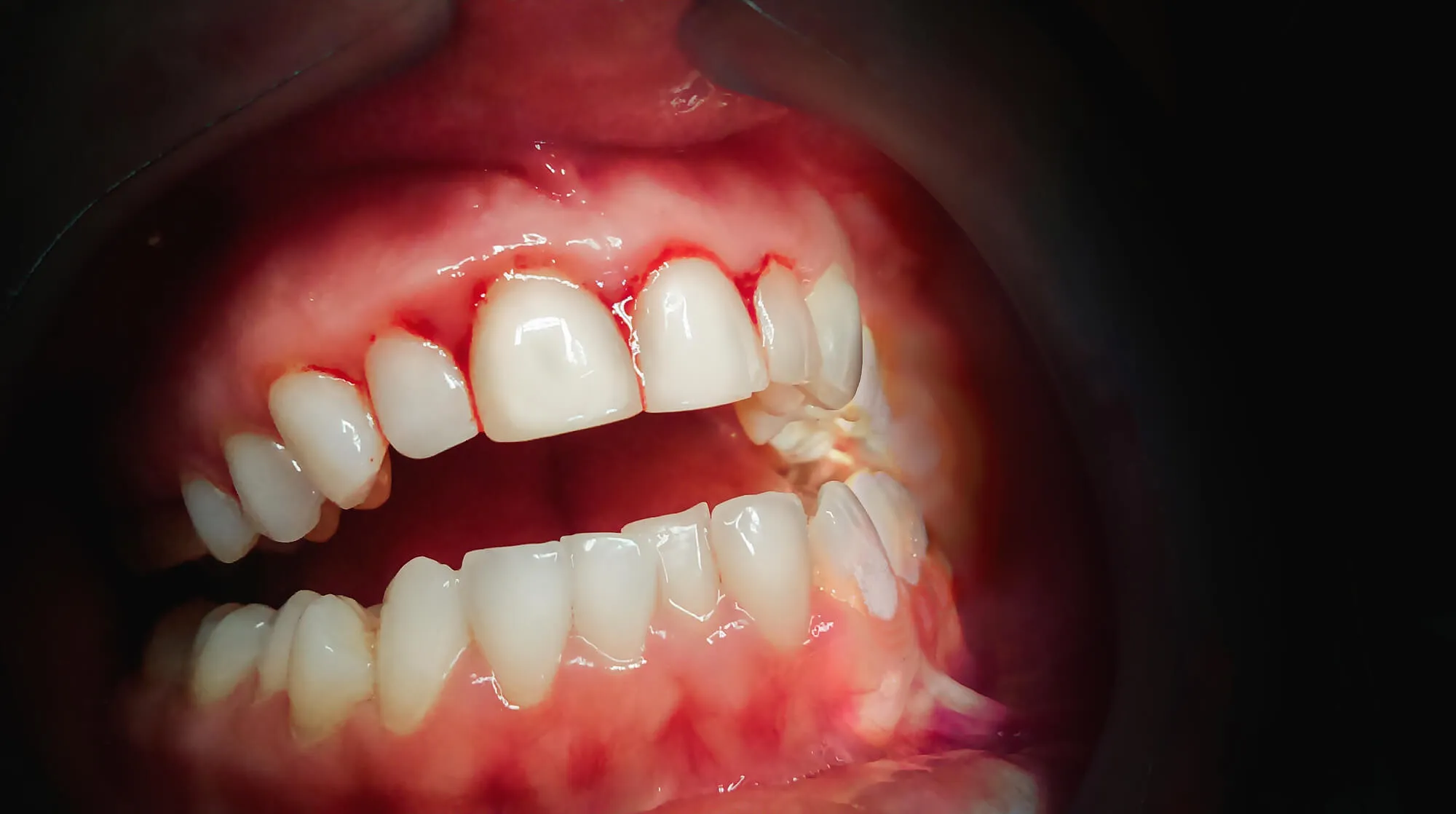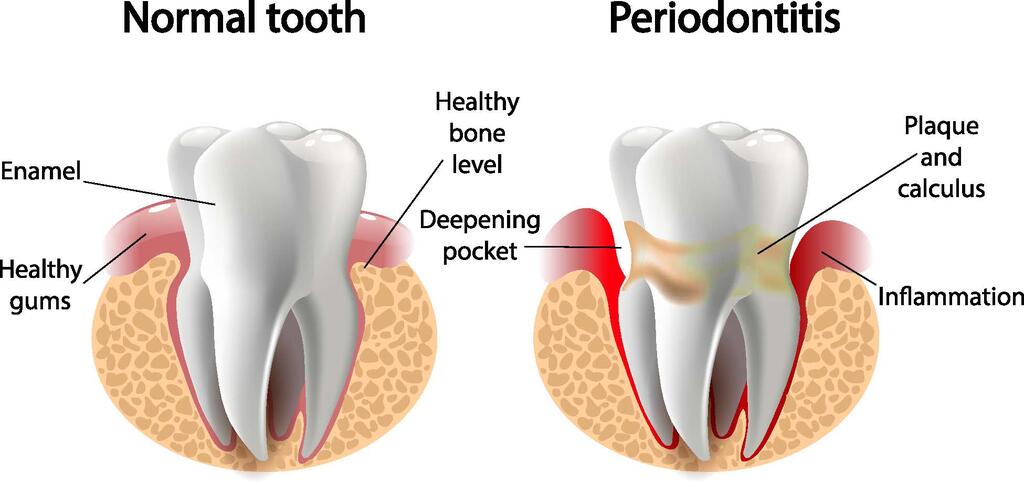Gum disease itself isn’t contagious, but the bacteria causing it can transfer through saliva exchange when kissing or sharing utensils. While this bacterial transmission occurs, factors like your immune response, oral hygiene habits, and genetics determine whether you’ll develop gum disease. You can protect yourself by maintaining good oral care, avoiding sharing toothbrushes, and scheduling regular dental checkups. Understanding transmission risks helps you better safeguard your oral health.

Key Takeaways
- Gum disease is not directly contagious, but the bacteria causing it can be transmitted through saliva exchange.
- The oral microbiome contains over 700 bacterial species that exist in balance in healthy mouths.
- Kissing, sharing utensils, or toothbrushes can transfer bacteria associated with gum disease.
- Individual factors like oral hygiene, immune response, and genetics determine if transferred bacteria cause disease.
- Prevent bacterial transmission by maintaining good oral hygiene, avoiding sharing oral items, and regular dental checkups.
Understanding Gum Disease and Its Causes
Inflammation, redness, and bleeding gums are telltale signs of gum disease, a common oral health condition affecting millions worldwide. This condition begins when bacteria in plaque build up along your gumline, irritating the surrounding tissue.
Gum disease occurs in two main stages: gingivitis and periodontitis. Gingivitis, the milder form, can often be reversed with proper oral hygiene. If left untreated, it progresses to periodontitis, which damages the soft tissue and bone supporting your teeth.
Several factors increase your risk, including poor brushing habits, irregular dental visits, smoking, hormonal changes, certain medications, and genetic predisposition.
Maintaining good gum health requires daily brushing, flossing, and professional cleanings. Remember, while bacteria cause gum disease, your daily habits largely determine your susceptibility.
The Science Behind Bacterial Transmission in Oral Health
While many people wonder if they can “catch” gum disease like a cold, the truth involves a more nuanced comprehension of oral bacteria. The mouth naturally hosts over 700 species of bacteria that form your unique oral microbiome.
Gum disease isn’t “caught” like a cold—it develops when your mouth’s natural bacterial balance is disrupted.
When you exchange saliva through kissing or sharing utensils, you’re transferring some of these bacterial colonies.
However, mere exposure to harmful bacteria doesn’t guarantee gum disease. Your body’s immune response, existing oral microbiome, and oral hygiene practices all influence whether transmitted bacteria can establish themselves.
People with healthy mouths typically maintain a balanced microbiome that prevents pathogenic bacteria from causing infection. It’s the imbalance of bacteria—not just their presence—that contributes to gum disease development, making “contagion” markedly different from how we perceive respiratory infections.
Risk Factors That Increase Susceptibility to Gum Disease

Although gum disease isn’t directly contagious in the traditional sense, certain factors can greatly increase your vulnerability to developing it after bacterial exposure. Your genetic predisposition plays a significant role, as some individuals inherit weaker immune responses to oral bacteria or naturally thinner gum tissues.
Your lifestyle choices dramatically impact susceptibility as well. Smoking suppresses your immune system’s ability to fight infections, while poor nutrition, especially vitamin C deficiency, impairs gum healing.
Inconsistent oral hygiene allows bacterial buildup, and stress can weaken your body’s defenses. Certain medications that reduce saliva production create a drier environment where bacteria thrive.
If you have diabetes or autoimmune conditions, you’ll face higher risks due to compromised healing abilities and inflammatory responses.
Preventing the Spread of Harmful Oral Bacteria
Understanding your risk factors allows you to take appropriate measures to prevent harmful oral bacteria from spreading.
Maintain excellent oral hygiene by brushing twice daily with fluoride toothpaste and flossing at least once a day to remove plaque where bacteria thrive.
Effective bacteria management includes replacing your toothbrush every 3-4 months and after illnesses.
Don’t share toothbrushes or eating utensils, especially with those who’ve active gum disease.
Consider using antimicrobial mouthwash to reduce bacterial load in your mouth.
Regular dental checkups are essential for professional cleaning and early detection of gum issues.
If you’re at high risk due to genetics or health conditions, your dentist might recommend more frequent visits or specialized oral care products designed for bacteria control.
Treatment Options for Those Affected by Periodontal Disease
Once periodontal disease develops, prompt and appropriate treatment becomes essential to prevent further damage and potential tooth loss.
Your dentist will likely recommend scaling and root planing, a deep-cleaning procedure that removes plaque and tartar from below the gumline and smooths root surfaces to discourage future bacterial buildup.
For more advanced cases, antimicrobial therapy may be prescribed alongside mechanical cleaning.
These medications—delivered as mouth rinses, gels, or oral antibiotics—target harmful bacteria and reduce inflammation.
In severe situations, surgical interventions like flap surgery or bone and tissue grafts might be necessary.
Conclusion
While gum disease itself isn’t contagious, the bacteria causing it can transfer through kissing, sharing utensils, or other close contact. You’re not catching “gum disease” but rather the harmful bacteria that may trigger it if your oral health is vulnerable. Shockingly, nearly 50% of adults over 30 have some form of periodontal disease. Maintain your oral hygiene routine, limit sharing personal items, and visit your dentist regularly to protect yourself and your loved ones